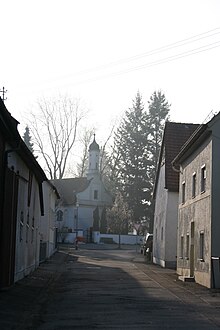St. Maria (Krumbach)
The Catholic cemetery chapel in Krumbach's west cemetery , consecrated to St. Mary , was built in the 18th century as a votive church. It is also known as the field chapel or the Gottesackerkapelle. The name field chapel comes from the fact that the chapel was still outside the market or the city of Krumbach until the 20th century . The building has always been known as the Gottesackerkapelle because the cemetery, now known as the Westfriedhof , in which the chapel is located, was established in the year in which the first small chapel was built - 1733. The cemetery was moved out of the city because the previous Krumbach cemetery - around the parish church of St. Michael - became too small.
history
The building history of the little church has not yet been fully clarified. In the years 1733/1734, a first small chapel was built to commemorate a miraculous healing that is said to have taken place a few years earlier on a statue near today's chapel. Due to the miraculous healing, a pilgrimage quickly developed to the chapel. The lords of the neighboring town of Krumbach, the Niederraunau lordship , feared that their pilgrimage chapel, the Ecce Homo chapel on the western outskirts of Niederraunau, would be less visited by the new pilgrimage chapel near Krumbach , because it also meant a loss of income . For this reason they used their influence so that the pilgrimage to the chapel near Krumbach was hindered as far and for as long as possible. This succeeded for almost 40 years by preventing the building from being expanded or rebuilt, with the result that the chapel, which was enlarged once during this time, always looked like a temporary solution and the structural condition always deteriorated. After these quarrels with Niederraunau came to an end, the Krumbachers quickly decided to enlarge the chapel again.
To this day it has not been definitively clarified who built the extension in 1774. Often Johann Martin Kraemer , the builder of the parish church St. Michael in Krumbach, or Kaspar Radmiller, the builder of the Thannhausen parish church Mariae Himmelfahrt are mentioned. Some details in the design of the chapel speak for the latter.
In 1977 the chapel was completely renovated.
Furnishing
Due to the fact that it was built towards the end of the 18th century, you can already see the first features of the classicistic design language in the building. The frescoes in the choir of the chapel are by Jakob Fröschle , the ceiling fresco in the nave, which depicts the Adoration of the Shepherds, by Konrad Huber, both artists from the region.
The figure of the Virgin Mary, created around 1480 by an artist from the Ulm School , which comes from the original statue where the miraculous healing is said to have taken place, is considered to be special . The lay chairs dated 1779 should also be emphasized. The high altar made of gray marble - created in 1848 by Gostner, a stonemason from Füssen - with neo-baroque angels and a neo-Gothic crucifix is rather unusual. The latter was replaced in 1977 by the painting Pietà by Johann Baptist Dollenbacher.
literature
- Bernt von Hagen, Angelika Wegener-Hüssen: Landkreis Günzburg (= Bavarian State Office for Monument Preservation [Hrsg.]: Monuments in Bavaria . Volume VII.91 / 1 ). Karl M. Lipp Verlag, Munich 2004, ISBN 3-87490-589-6 , p. 298-299 .
Web links
Coordinates: 48 ° 14 '22.9 " N , 10 ° 21' 36.9" E
